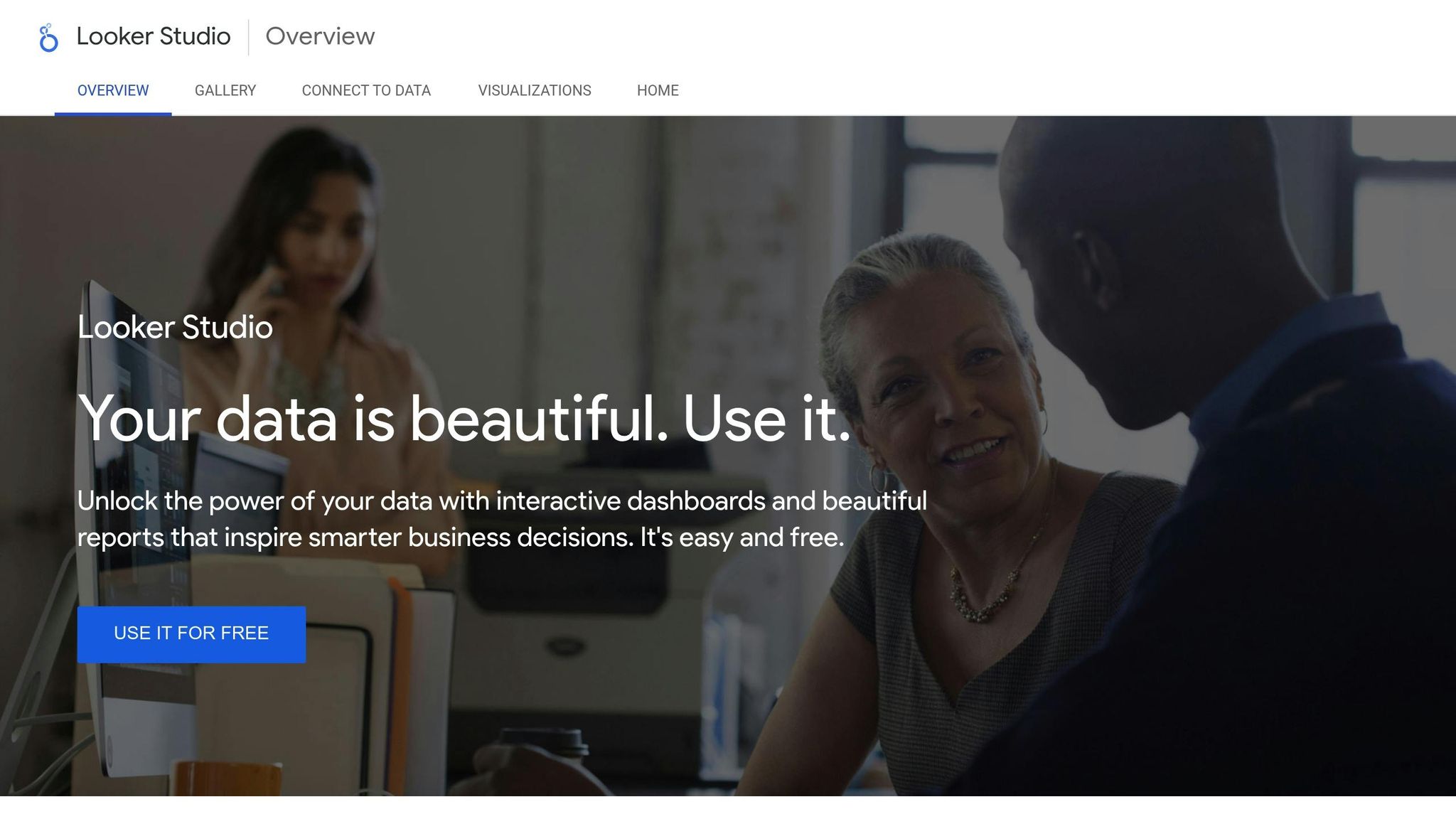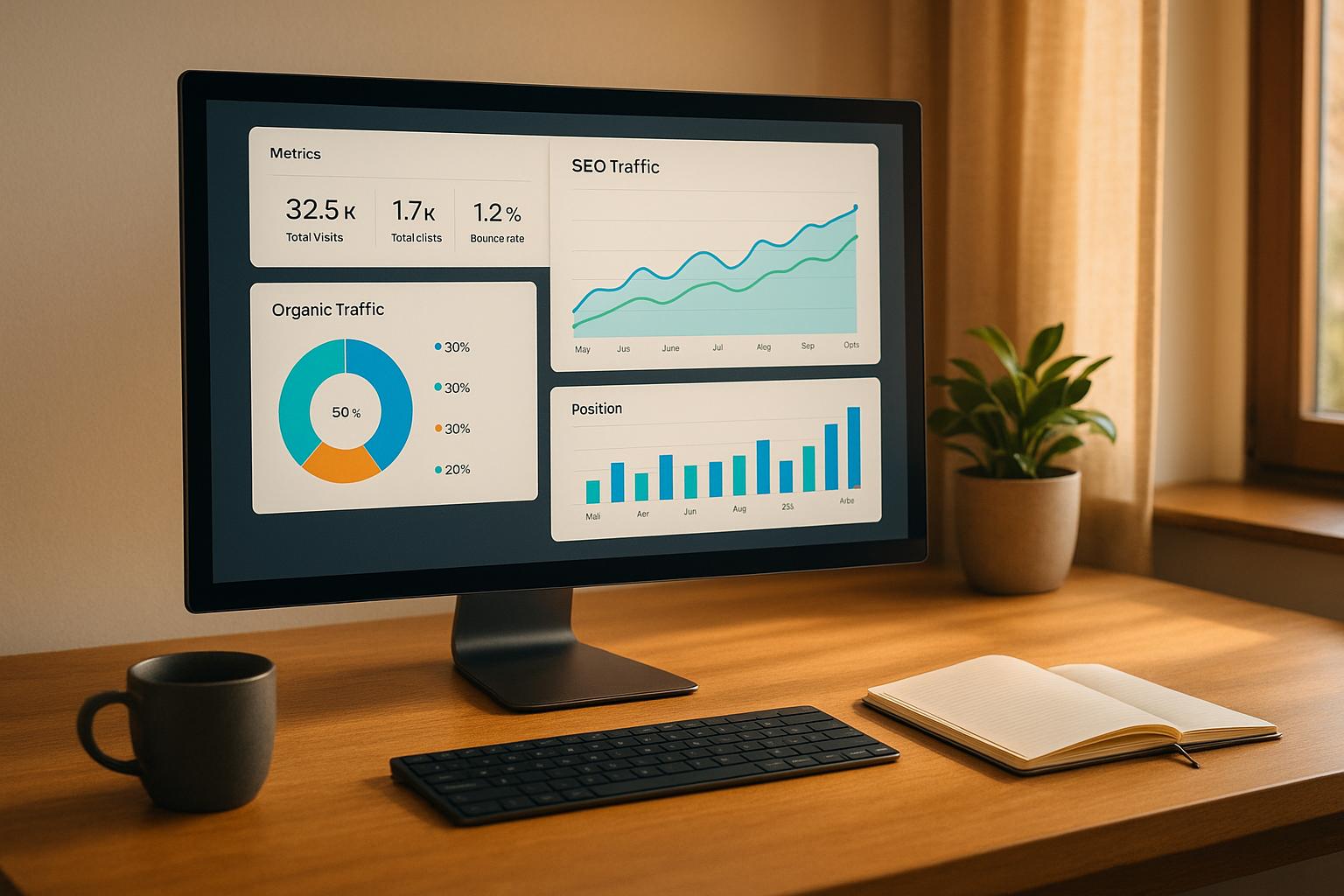Interactive SEO dashboards simplify complex data, helping you track and improve your website’s performance in real-time. They consolidate metrics like traffic, rankings, and conversions into a single, actionable view. Here’s what makes them useful:
- Track Performance: Monitor rankings, traffic, and conversions.
- Analyze Competitors: Spot growth opportunities.
- Technical SEO Insights: Identify and fix issues like crawl errors or slow site speeds.
- Customizable Views: Tailor data for executives, content teams, or technical SEO specialists.
Key features include live data integration, interactive filters, and role-based views to ensure the right teams access the right data. Tools like Looker Studio and advanced platforms like the Propensity Engine make setup easier by connecting multiple data sources and linking SEO efforts to revenue.
For a successful dashboard:
- Use tools like Google Analytics and Search Console for data.
- Add filters, date controls, and drill-downs for better insights.
- Prioritize fast load times (under 3 seconds) and regular data quality checks.
These dashboards save time, improve decision-making, and help optimize your SEO strategy effectively.
Build an SEO Dashboard in Looker Studio (Data Studio)

Core Elements of SEO Dashboards
These elements ensure your dashboard doesn’t just display data – it helps shape your SEO strategy.
Live Data Sources
The backbone of any SEO dashboard is its ability to pull updated data from multiple sources. Tools like Google Search Console and Google Analytics 4 are often the primary feeds, offering key metrics about your website’s performance. Keep in mind: GA4 updates typically within hours, while Search Console data may take 2–3 days to refresh.
To streamline this process, use API-based connectors to automate data updates while staying within API rate limits (e.g., Google Analytics allows up to 50,000 requests daily). Schedule these updates during low-traffic periods to avoid disruptions.
Now, let’s look at how interactive features can turn raw data into actionable insights.
Interactive Features
Interactive elements are essential for diving deeper into your data:
| Feature Type | Purpose | Example Implementation |
|---|---|---|
| Date Controls | Compare time periods | Analyze Q1 2025 (01/01/2025–03/31/2025) vs. Q4 2024 (10/01/2024–12/31/2024) |
| Filters | Segment analysis | Toggle between mobile and desktop traffic |
| Drill-downs | Explore details | Click from page performance to view keyword rankings |
To keep your dashboard responsive while offering these features, consider caching frequently accessed metrics. Also, limit granularity to weekly trends instead of hourly updates – this can improve load times by 40–60%.
Next, customizing views based on user roles can make your dashboard even more effective.
Role-Based Views
Customizing views to align with team roles ensures everyone gets the information they need:
Executive View:
- Key metrics like organic traffic growth
- Month-over-month performance trends
- ROI from SEO efforts
Content Team View:
- Metrics on content performance
- Average time on page (e.g., 2 minutes 45 seconds)
- Top-performing pages and topics
Technical SEO View:
- Crawl error reports
- Site speed data (e.g., First Contentful Paint)
- Overall technical health scores
"78% of agencies using role-based dashboards report improved client retention rates" – AgencyAnalytics 2024 survey
To keep these views secure, use OAuth 2.0 authentication and mask sensitive data with ranges (e.g., $10K–$15K monthly revenue). This approach ensures stakeholders see only what’s relevant while safeguarding confidential information.
Dashboard Building Software
Now that you understand dashboard features, the next step is choosing the right software. Options range from basic tools for tracking metrics to advanced platforms that connect SEO efforts directly to revenue. Below, we’ll look at popular dashboard tools and how thezechners’ Propensity Engine can refine your strategy.
Common Dashboard Tools
Looker Studio leads the market, thanks to its smooth integration with Google products. By early 2025, it supports access to over 300 data connectors, making it ideal for SEO teams juggling data from multiple sources. Many tools also offer flexible integration methods, including direct API connections, CSV uploads, and custom connectors, to unify data from sources not natively supported.
Using thezechners’ Propensity Engine

The Propensity Engine takes dashboard creation to the next level by linking SEO efforts directly to revenue. Here’s how it works:
1. Data Infrastructure Setup
Compatible with Google Cloud Platform and AWS S3 buckets, the Propensity Engine requires 3–5 business days to configure. It’s designed to handle large-scale SEO data with ease.
2. Dynamic SERP Integration
Rankings are updated every 2 hours, giving quicker insights into changes during core algorithm updates.
3. Security Implementation
Retention policies can be customized to delete unused keywords after 90 days. For medical SEO campaigns, HIPAA-compliant setups are available upon request.
The Propensity Engine has already delivered measurable results. For example, Tracklytics, an Austin-based SaaS company, boosted trial signups by 33% through improved keyword targeting. The platform’s device-specific propensity scores showed that 68% of "near me" searches performed better on mobile, enabling teams to optimize content for specific devices. For budget-conscious teams, the Propensity Engine offers a performance-based pricing model, charging 7–12% of verified SEO revenue gains. Saveda, a Boston-based agency, saved $23,000 annually by switching from Tableau to a hybrid setup combining Looker Studio and the Propensity Engine.
sbb-itb-3726a71
Building Your SEO Dashboard
Setup and Data Selection
Start by identifying key performance indicators (KPIs) like organic traffic, keyword rankings, and conversion rates (typically 1%–3% for U.S. e-commerce). These metrics should directly connect to revenue to measure success effectively.
Organize your dashboard by grouping metrics into logical categories:
| Dashboard Layer | Key Metrics | Update Frequency |
|---|---|---|
| Executive View | Traffic, Revenue, Market Share | Daily |
| Technical SEO | Core Web Vitals, Crawl Errors | Weekly |
| Content Performance | Rankings, CTR, Backlinks | Real-time |
Once you’ve outlined the metrics, integrate data sources to streamline reporting.
Data Integration Steps
Follow these steps to integrate data sources, starting with Google Search Console in Looker Studio:
- Create a new data source and choose the Search Console connector.
- Select the relevant ‘Site’ property and verify your domain.
- Set the date range in MM/DD/YYYY format and map dimensions like keywords, URLs, and geodata.
To keep your dashboard running smoothly, schedule data refreshes during off-peak hours (e.g., 3 AM EST). After integration, make your dashboard more dynamic by adding interactive controls.
Adding User Controls
Make your reports more engaging by introducing interactive controls:
Primary Filters
- Date range selectors (default to year-over-year comparisons)
- Geographic filters for U.S. regions
- Device type toggles to switch between desktop and mobile data
Advanced Features
- Track keyword positions within ±5 spots.
- Use CTR comparison sliders for quick insights.
- Add revenue attribution toggles to align metrics with business goals.
If using the Zechners’ Propensity Engine, enable its predictive CTR modeling feature, which offers an accuracy of ±8% for U.S. markets. This tool also provides automated alerts for keywords with low propensity scores (below 50%), helping teams focus on areas that need improvement.
For enterprise-level dashboards, implement role-based access. Place high-level metrics for executives in the upper left quadrant, while detailed technical data should be displayed in sections below for specialized teams.
Dashboard Maintenance Guide
Speed and Reliability
The performance of a dashboard plays a major role in how often it’s used and how well it supports data-driven decisions. To keep load times under 3 seconds, use lightweight libraries like Chart.js or D3.js, enable browser caching, and implement API pagination. Why 3 seconds? Because 89% of users abandon dashboards that take longer to load.
For compatibility across devices, set responsive breakpoints at 768px for tablets and 480px for phones, using relative units to ensure the layout adjusts seamlessly.
Usage Analytics
Once your dashboard is fast and reliable, it’s time to focus on how users interact with it. Track key metrics like session duration (aim for over 2.5 minutes) and feature usage. For example, the Propensity Engine shows that dashboards with a 55% filter interaction rate tend to perform better.
"OZ Global B2B’s 2023 technical audit for a manufacturing client identified 127 crawl errors through daily monitoring. Fixing these improved organic visibility by 58% within 90 days."
Set up automated alerts to monitor:
- Data freshness: Notify if no new data arrives within 24 hours.
- API health: Check every 15 minutes for any issues.
- Traffic fluctuations: Alert if weekly traffic changes by more than 20%.
Data Quality Checks
Keeping your data accurate is non-negotiable. Use daily automated checks with tools like the Google Search Console API and perform weekly cross-source validations to keep discrepancies below 5%. For enterprise dashboards, create a truth table to prioritize data sources in this order:
- First-party analytics (e.g., GA4)
- Paid SEO tools
- Free market data
The Propensity Engine’s machine learning can predict when dashboard performance might drop and send alerts 14 days in advance, helping teams address data drift before it becomes an issue. This strategy has cut data inaccuracies by 67%.
Don’t forget quarterly maintenance tasks like rotating API keys and reauthorizing OAuth tokens. The Google Analytics 4 migration in 2023 highlighted why this is essential – 38% of dashboards faced disruptions due to outdated libraries by Q3.
For real-time performance tracking, tools like DataDog or UptimeRobot are highly effective. Companies that conduct weekly data audits detect errors 38% faster, leading to more reliable insights and better decisions.
Conclusion
Interactive SEO dashboards play a key role in making data-driven decisions. They can speed up decision-making by 37% and boost campaign ROI by 28% compared to static reports. These tools also enhance workflows, with automated dashboards reducing manual reporting time by 40%, allowing teams to focus on higher-level tasks.
By combining real-time data with strict quality checks, you can maximize these advantages. For example, the Propensity Engine’s machine learning has helped clients see a 19% increase in organic traffic in Q3 2024 by detecting keyword cannibalization in real-time. This approach consistently maintains prediction accuracy above 92%.
For optimal results, prioritize these actions:
- Run monthly data quality audits with automated anomaly detection tools.
- Ensure fast load times, keeping them under 3 seconds on all devices.
- Conduct quarterly UX testing with real users to refine the dashboard experience.
- Set up automated alerts to monitor data freshness and API performance.
These steps solidify the strategies we’ve covered. The landscape of SEO dashboards is changing quickly, with Gartner projecting that by 2026, 45% of SEO platforms will feature GenAI-powered anomaly detection. Combined with natural language interfaces and predictive analytics, these advancements are reshaping how organizations track and improve their SEO efforts.
FAQs
How do interactive SEO dashboards enhance decision-making compared to static reports?
Interactive SEO dashboards provide a dynamic way to analyze and visualize data, offering significant advantages over static reports. With real-time updates, they allow you to monitor performance metrics as they change, ensuring decisions are based on the most current information.
Unlike static reports, interactive dashboards let you drill down into specific data points, filter by variables like time periods or campaigns, and customize views to focus on what matters most to your goals. This level of flexibility helps identify trends, uncover opportunities, and respond quickly to challenges, ultimately leading to more informed and effective decision-making.
How can I ensure the data in my SEO dashboards is accurate and reliable?
To ensure your SEO dashboards provide accurate and reliable data, focus on a few key areas:
- Data Sources: Use trusted and verified tools for data collection, such as Google Analytics or Search Console, and ensure they are properly integrated.
- Consistency: Regularly review your data inputs to ensure consistency in metrics, timeframes, and formats.
- Validation: Cross-check data against multiple sources to identify discrepancies and correct errors.
- Automation: Automate data updates where possible to minimize manual errors and keep your dashboard current.
By prioritizing these steps, you can maintain high data quality and make informed decisions based on your dashboards.
How can role-based views make SEO dashboards more effective for different teams?
Role-based views allow SEO dashboards to be customized for the specific needs of different teams, ensuring each group has access to the most relevant data. For example, marketing teams might focus on keyword performance and campaign ROI, while technical teams can monitor site speed and crawl errors.
By tailoring the dashboard to individual roles, teams can quickly access actionable insights without being overwhelmed by unnecessary data. This improves efficiency, enhances collaboration, and helps each team make more informed decisions aligned with their goals.
